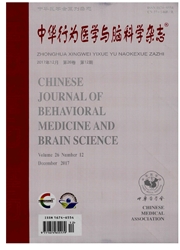

 中文摘要:
中文摘要:
目的 探讨生理脱毒期阿片类药物依赖者线索诱发作业下与伏隔核存在异常功能连接的脑区及其在戒断复吸中的作用.方法 生理脱毒期阿片类药物依赖组和健康对照组各18例,在观看与阿片类药物依赖线索相关视频时进行功能磁共振成像扫描,分别选取左、右侧伏隔核为感兴趣区进行功能连接分析,确定与双侧伏隔核存在功能连接的脑区.结果 与健康对照组相比,生理脱毒期阿片类药物依赖组的伏隔核与前额叶(46,29,-9)、岛叶(31,25,-7)、后扣带回(4,-59,19)、楔前叶(4,-63,22)、枕叶(6,71,16)、舌回(11,-37,-8)和距状回(3,-45,7)的功能连接明显高于健康对照组,而与丘脑(-8,-13,2)、前扣带回(-2,44,20)功能连接明显低于健康对照组(P<0.05).结论 生理脱毒期阿片类药物依赖者线索诱导下的伏隔核存在功能异常,这可能是其容易复吸的重要原因之一.
 英文摘要:
英文摘要:
Objective To explore the brain areas which have abnormal functional connectivity with nucleus accumbens in opiate drug addicts during physical detoxification nsing a cue-elicited task-related functional magnetic resonance imaging (fMRI),and to find out the role of nucleus accumbens dysfunction in the relapse of opiate drug dependence during physical detoxification.Methods Eighteen participants of opiate drug addicts during physical detoxification,and eighteen healthy controls performed a cue-elicited craving task in a MRI scanner while signal data were collected.The left and right nucleus accumbens were selected as regions of interest (ROIs) respectively,and calculated the linear correlation between the nucleus accumbens and the entire brain to find out the functional connectivity of the nucleus accumbens.Results Compared with the controls,the functional connectivity between the nucleus accumbens and the prefrontal cortex (46,29,-9),insula(3 1,25,-7),posterior cingutate (4,-59,19),precuneus(4,-63,22),occipital lobe(6,71,16),lingual gyrus(11,-37,-8),calcarine (3,-45,7) in the opiate drug addicts during physical detoxification group were increased(P<0.05),and the functional connectivity between the nucleus accumbens and thalamus(-8,-13,2),anterior cingutate(-2,44,20) were decreased(P<0.05).Conclusion The nucleus accumbens dysfunction of functional connectivity in a cue-elicited craving task may play a important role in the relapse of opiate drug dependence during physical detoxification.
 同期刊论文项目
同期刊论文项目
 同项目期刊论文
同项目期刊论文
 期刊信息
期刊信息
